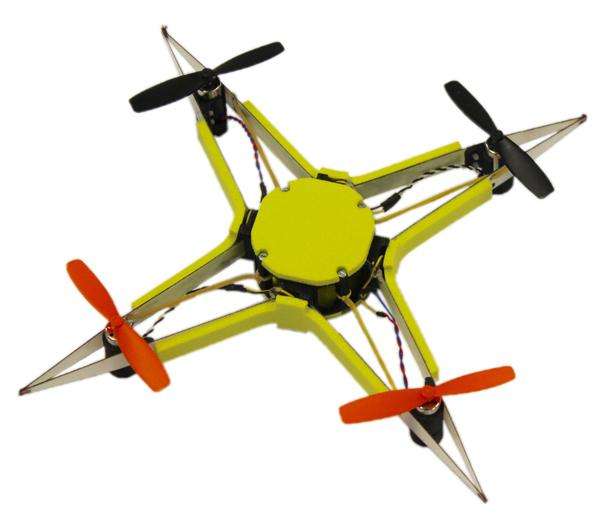March 10, 2017 weblog
Drone approach to survive collision: Be flexible, be rigid, be insect

Taking on a bioinspired strategy in the field of robotics is nothing new. Especially in the case of insects, researchers far and wide look to them for inspiration. Tracey Lien in Los Angeles Times said many robots have been built just to better understand insects themselves.
In recent years though, engineers have made significant breakthroughs in adapting some of nature's best designs for robotics."
A new example comes from Switzerland where researchers are adapting the biomechanical strategy of collision resilient insects' wings. They are applying the strategy to flying drones. Their paper is "Insect-Inspired Mechanical Resilience for Multicopters," by Stefano Mintchev and his colleagues.
If insects can withstand collision, how about applying the construct to crash-resistant quadcopters? If bulky frames serving as protective cages are vulnerable to failure in high-speed impact, what is an alternative construct? The researchers, said Trevor Mogg in Digital Trends, were interested in designing "a more durable drone that's free of a bulky cage or other protective structures that we've seen before.
The researchers have a drone that is flexible and can easily deform, yet rigidly locks around the case through magnets.
If we are going to make headway in resilient flying machines in disaster and rescue operations, where things can get quite messy and cluttered, then fresh ideas in making flying robots to be as robust as possible is a contribution.
"Improving on a previous iteration of a folding quadcopter, Stefano Mintchev, the lead researcher on a project, has come up with a quadcopter using properties seen in insect wings, said a news item from the Switzerland-based Laboratory of Intelligent Systems, EPFL.
Digital Trends described their approach as a design moving from rigid to flexibility. "Having noted the flexibility and durability of insect wings—and how the flying bugs never seem to be particularly put out if they slam headfirst into an obstacle such as a window—the team wondered if it could apply such characteristics to drone design."
(Nature noted in its "Research Highlights" section that "wasps have wings with flexible joints that allow the wings to deform during collisions.") Nature described their work as "a remote-controlled drone with flexible fibreglass arms."
The design involves a thin fibreglass frame only 0.3mm thick, with four arms held together by four magnetic joints.
The four magnetic joints connect the frame to the case, modeled after hard insect exoskeletons.
The authors said their approach was validated "in a 50g quadcopter that can withstand high speed collisions."
By "dual stiffness," the authors said the frame rigidly withstands aerodynamic loads within the flight envelope, but can soften and fold during a collision to avoid damage.
"Where these magnets come into their own, is that during a collision they break, meaning that the drone transition to a soft state where the frame becomes disengaged and can safely deform without damaging itself or the inner core."
(You can check out the video, Insect-Inspired Mechanical Resilience for Multicopters, which shows the external frame and case.)
During flight, the drone is rigid. During collisions, the drone is flexible. The team had a drop test from 2m high. "The collision resistant drone was tested by dropping it from a height of 2m whereby it completely disengaged the magnetic joints and automatically restored to its pre-crash configuration," said the news item from EPFL.
As for results, "the drone was dropped over 50 times with no permanent damage."
Why their work matters: Digital Trends said, "Some of the features could one day work their way into consumer drones to make them more durable and less likely to break upon impact."
More information: Stefano Mintchev et al. Insect-Inspired Mechanical Resilience for Multicopters, IEEE Robotics and Automation Letters (2017). DOI: 10.1109/LRA.2017.2658946
© 2017 Tech Xplore


















